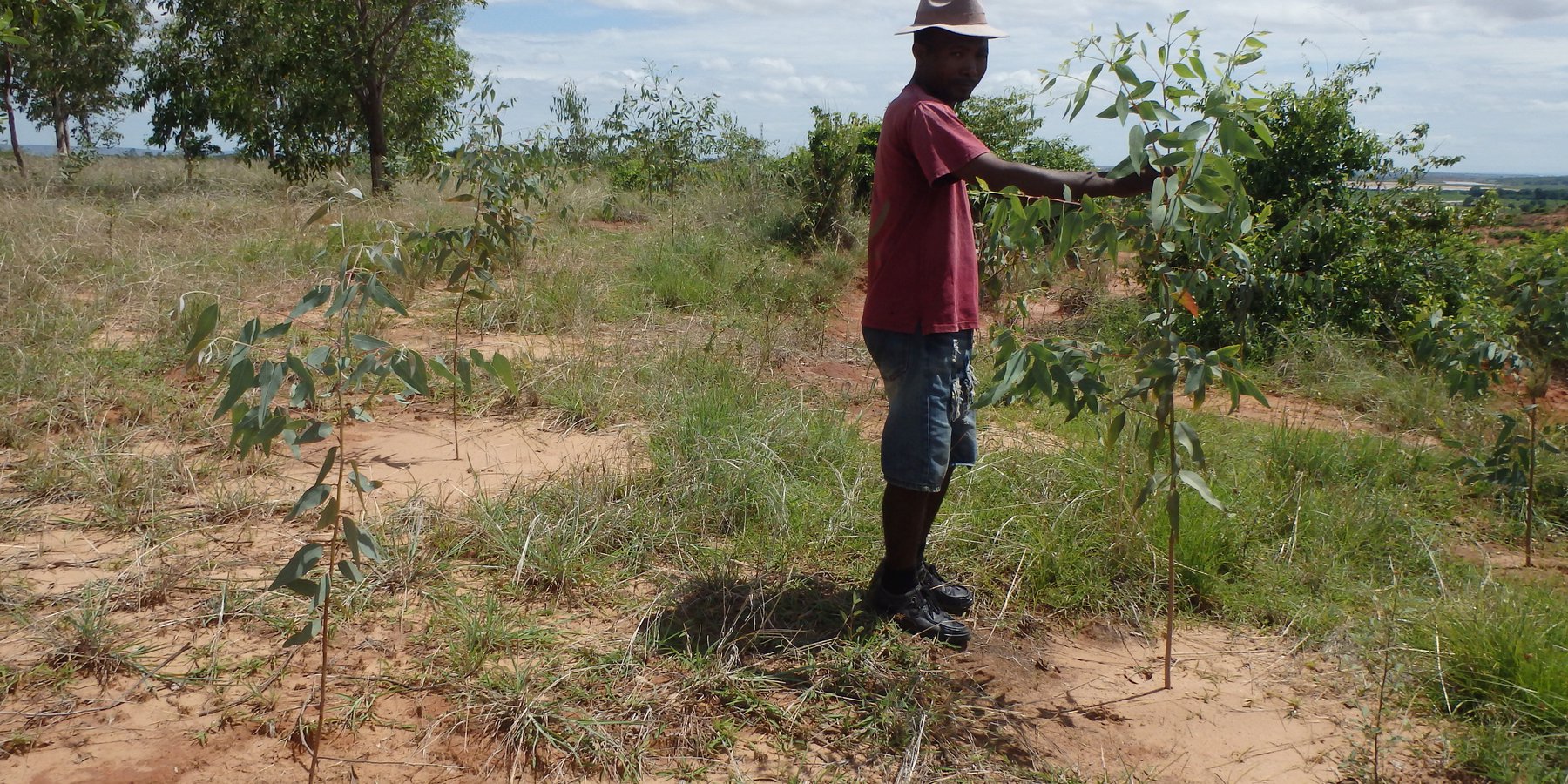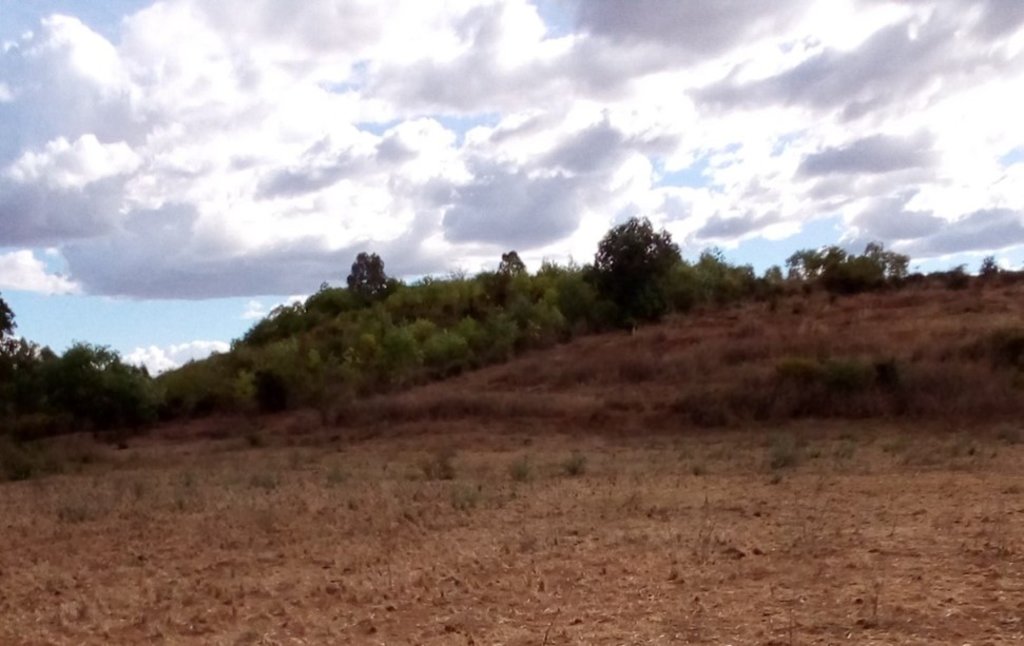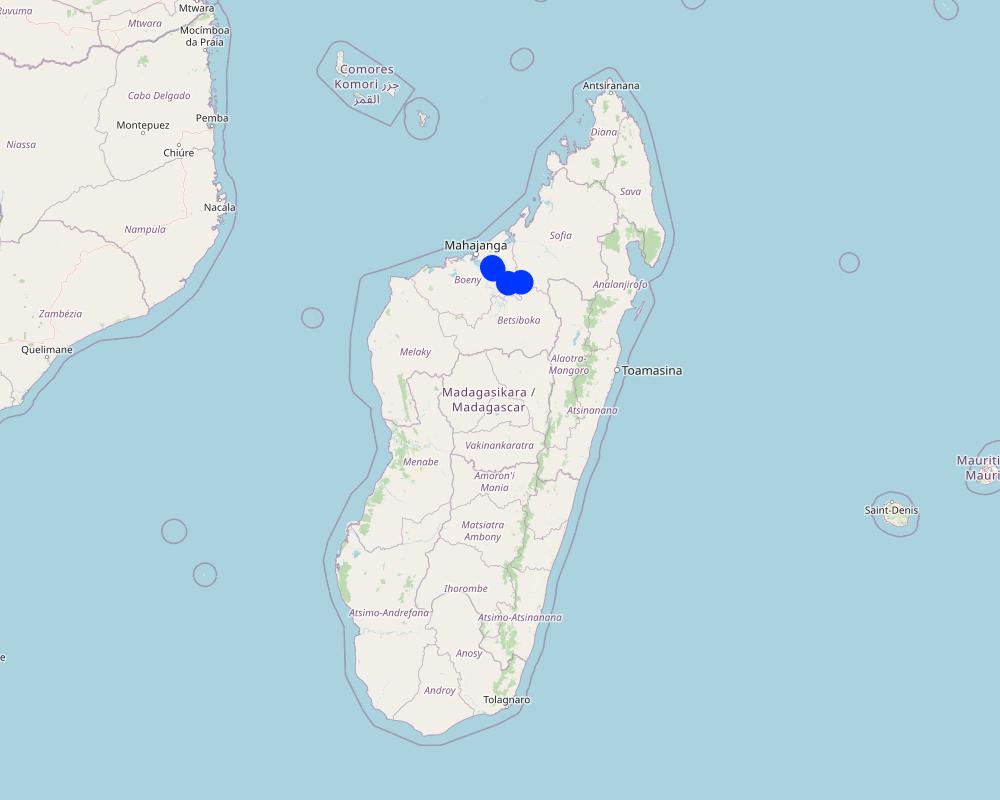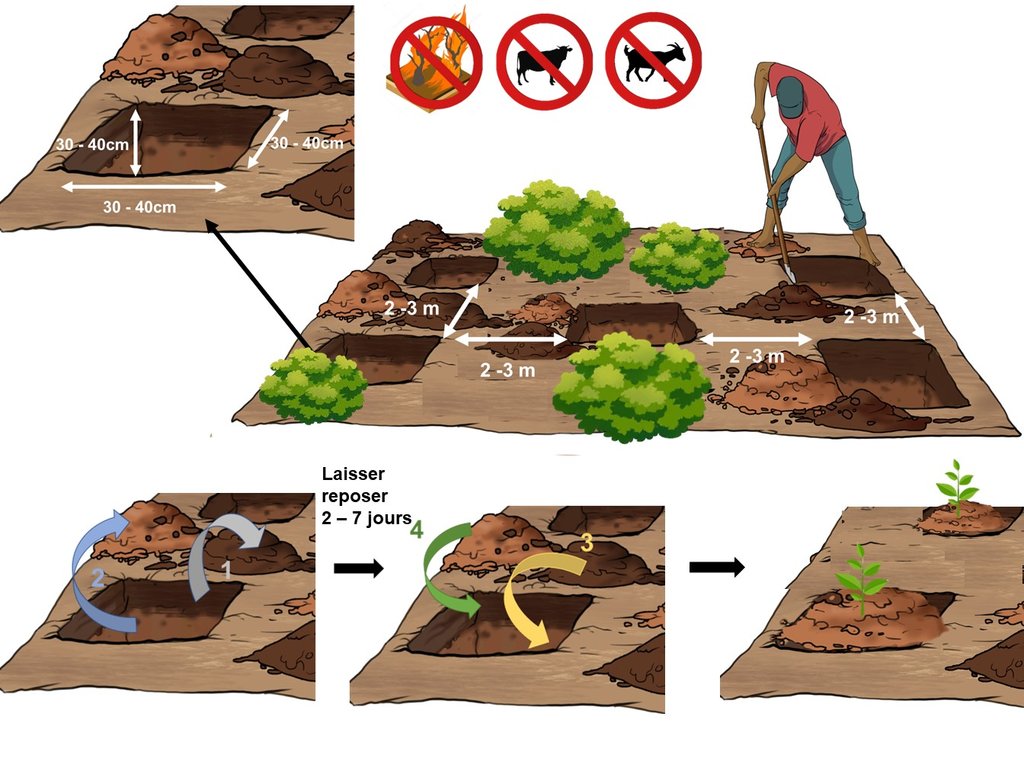Crop Exclosures [Madagascar]
- Creation:
- Update:
- Compiler: Harifidy RAKOTO RATSIMBA
- Editors: Felana Nantenaina RAMALASON, Dimby RAHERINJATOVOARISON, Siagbé Golli, Tahiry Ravivonandrasana, Natacha Rabeary, Tabitha Nekesa, Ahmadou Gaye
- Reviewers: William Critchley, Rima Mekdaschi Studer
Kirihitrala arovana, Kirihitr'ala arovana ka tsy kitihana
technologies_6473 - Madagascar
View sections
Expand all Collapse all1. General information
1.2 Contact details of resource persons and institutions involved in the assessment and documentation of the Technology
Key resource person(s)
land user:
RAZANIZAKASON Albert Ferdinand
Madagascar
land user:
RAZAFINIRINA Nomenjanahary Daniel (ZAFY)
Madagascar
land user:
ANGELINE
Madagascar
land user:
FIADANA
Madagascar
land user:
VILISOA
Madagascar
Name of project which facilitated the documentation/ evaluation of the Technology (if relevant)
Soil protection and rehabilitation for food security (ProSo(i)l)Name of the institution(s) which facilitated the documentation/ evaluation of the Technology (if relevant)
Deutsche Gesellschaft für Internationale Zusammenarbeit (GIZ)1.3 Conditions regarding the use of data documented through WOCAT
The compiler and key resource person(s) accept the conditions regarding the use of data documented through WOCAT:
Yes
1.4 Declaration on sustainability of the described Technology
Is the Technology described here problematic with regard to land degradation, so that it cannot be declared a sustainable land management technology?
No
2. Description of the SLM Technology
2.1 Short description of the Technology
Definition of the Technology:
Crop exclusion means establishing sanctuaries where landowners and the surrounding population agree to no longer cultivate, opting instead for natural environmental regeneration (passive exclusion) or for land enrichment, mainly by planting forest species (active exclusion).
2.2 Detailed description of the Technology
Description:
Crop exclosures are created on hilltops and steep slopes where cultivation is not recommended due to erosion risks. Passive crop exclusion comprises leaving a forested area uncultivated and encouraging the natural regeneration of the environment, while protecting it from fire and roaming livestock. Active exclosures, on the other hand, consists in supporting natural regeneration through restoration (enrichment and reforestation). When applying this technology, preference should be given to indigenous species (Harungana madagascariensis, Albizia lebbeck, etc.) over fast-growing species (Eucalyptus spp, Acacia spp) in order to maintain the biological diversity of the environment.
The various stages involved in establishing either passive or active crop exclosures are as follows:
- organisation of a general information meeting to raise awareness and canvas the concerns of the surrounding population;
- participatory delineation of the area to be protected (local authorities, owners and users concerned, etc.);
- creation of a management committee;
- preparation of a crop exclusion plans;
- public consultation and validation of the projects;
- formalization in the Fokontany and commune;
- implementation.
The development of surrounding areas and the installation of fascines (vegetative checkdams) to control gullying may also be incorporated into the clearing process, as per the agreed-upon local arrangement. Crop exclusion helps downstream areas from silting up, preserves soil fertility and regenerates degraded lands. It also improves infiltration and reduces erosion and soil loss.
The branches of regenerated trees can be sustainably harvested according to specific needs, such as fodder, wood, or organic matter for mulching purposes. Additionally, non-wood products can be gathered on these plots, including honey, medicinal plants, and species used for traditional knowledge-based or "ady gasy" products.
2.3 Photos of the Technology
2.5 Country/ region/ locations where the Technology has been applied and which are covered by this assessment
Country:
Madagascar
Region/ State/ Province:
Boeny
Further specification of location:
Tsaramandroso, Antanambao Andranolava, Marovoay Banlieue, Manerinerina
Specify the spread of the Technology:
- evenly spread over an area
If precise area is not known, indicate approximate area covered:
- < 0.1 km2 (10 ha)
Is/are the technology site(s) located in a permanently protected area?
No
Map
×2.6 Date of implementation
Indicate year of implementation:
2020
If precise year is not known, indicate approximate date:
- less than 10 years ago (recently)
2.7 Introduction of the Technology
Specify how the Technology was introduced:
- through projects/ external interventions
Comments (type of project, etc.):
ProSoil Project
3. Classification of the SLM Technology
3.1 Main purpose(s) of the Technology
- improve production
- reduce, prevent, restore land degradation
- conserve ecosystem
- protect a watershed/ downstream areas – in combination with other Technologies
- preserve/ improve biodiversity
3.2 Current land use type(s) where the Technology is applied
Land use mixed within the same land unit:
No

Forest/ woodlands
- Tree plantation, afforestation
Tree plantation, afforestation: Specify origin and composition of species:
- Monoculture exotic variety
- Mixed varieties
Type of tree plantation, afforestation:
- tropical shrubland plantation - Eucalyptus spp.
- tropical shrubland plantation - broadleaf
- Eucalyptus, Acacia, Albizia lebbeck
Are the trees specified above deciduous or evergreen?
- deciduous
Products and services:
- Timber
- Fuelwood

Unproductive land
Specify:
Lands where cultivation is impossible or poses a threat to downstream crops
3.3 Has land use changed due to the implementation of the Technology?
Has land use changed due to the implementation of the Technology?
- Yes (Please fill out the questions below with regard to the land use before implementation of the Technology)
Land use mixed within the same land unit:
No

Cropland
- Perennial (non-woody) cropping
Perennial (non-woody) cropping - Specify crops:
- banana/plantain/abaca
- sugar cane

Forest/ woodlands
- (Semi-)natural forests/ woodlands
(Semi-)natural forests/ woodlands: Specify management type:
- Clear felling
Are the trees specified above deciduous or evergreen?
- deciduous
Products and services:
- Fuelwood

Unproductive land
Specify:
Acacia
3.4 Water supply
Water supply for the land on which the Technology is applied:
- rainfed
3.5 SLM group to which the Technology belongs
- forest plantation management
- improved ground/ vegetation cover
- integrated soil fertility management
3.6 SLM measures comprising the Technology

vegetative measures
- V1: Tree and shrub cover

management measures
- M1: Change of land use type
3.7 Main types of land degradation addressed by the Technology

soil erosion by water
- Wt: loss of topsoil/ surface erosion
- Wg: gully erosion/ gullying

biological degradation
- Bc: reduction of vegetation cover
- Bh: loss of habitats
- Bq: quantity/ biomass decline
- Bs: quality and species composition/ diversity decline
- Bl: loss of soil life
3.8 Prevention, reduction, or restoration of land degradation
Specify the goal of the Technology with regard to land degradation:
- reduce land degradation
- restore/ rehabilitate severely degraded land
4. Technical specifications, implementation activities, inputs, and costs
4.1 Technical drawing of the Technology
Technical specifications (related to technical drawing):
Exclosures primarily serve as conservation zones, and their success relies heavily on addressing the concerns of the local population and land users. Collaboration among stakeholders is essential to reach an agreement that is accepted and respected, encompassing aspects like the designation of conservation areas, delineation of exclosure area, and protection of the area from potential threats such as bushfires and livestock roaming.
Where enrichment is necessary (active exclosure), the following technical specifications should be considered:
- Holes with dimensions of 30 to 40 cm in length and width, and a depth of 30 to 40 cm.
Staggered placement of holes at intervals of 2 to 3 meters.
- A clear separation between the top and bottom layers of the hole. After excavation, the hole is left open for 2 to 7 days before the soil is reinstated. The initial top layer is placed at the bottom of the hole, while the initial bottom layer is positioned on the surface.
- Planting seedlings into the ground and covering them with dry plant material to retain moisture at the crown of the seedlings;
- Indications prohibiting grazing and the passage of fire, along with the establishment of firebreaks.
Author:
GIZ ProSoil Madagascar
Date:
02/24/2023
4.2 General information regarding the calculation of inputs and costs
Specify how costs and inputs were calculated:
- per Technology area
Indicate size and area unit:
1 hectare
other/ national currency (specify):
Ariary
If relevant, indicate exchange rate from USD to local currency (e.g. 1 USD = 79.9 Brazilian Real): 1 USD =:
4300.0
Indicate average wage cost of hired labour per day:
5000
4.3 Establishment activities
| Activity | Timing (season) | |
|---|---|---|
| 1. | Delineate the exclosure area | |
| 2. | Draw up a development plan with the local authorities (Fokontany) and landowners concerned | January-March |
| 3. | Establish a management committee for mass outreach sessions | No later than 1 week after harvesting |
| 4. | Implement the local convention | |
| 5. | Create a firewall | |
| 6. | Install signposts | |
| 7. | Plan the location of the nurseries | Before the rainy season |
| 8. | Plant nursery seedlings | Rainy season |
4.4 Costs and inputs needed for establishment
| Specify input | Unit | Quantity | Costs per Unit | Total costs per input | % of costs borne by land users | |
|---|---|---|---|---|---|---|
| Labour | Hole digging and seedling planting | man-days | 6.0 | 5000.0 | 30000.0 | 100.0 |
| Equipment | Seedlings | number | 100.0 | 700.0 | 70000.0 | |
| Total costs for establishment of the Technology | 100000.0 | |||||
| Total costs for establishment of the Technology in USD | 23.26 | |||||
If land user bore less than 100% of costs, indicate who covered the remaining costs:
The seedlings were procured by the GIZ ProSoil project.
Comments:
The listed costs pertain to active exclosures, as passive exclosures primarily involve maintaining the site free from livestock and fire.
4.5 Maintenance/ recurrent activities
| Activity | Timing/ frequency | |
|---|---|---|
| 1. | Weeding out the firewall area | Before the rainy season |
| 2. | Protection against cattle grazing (optional) | All year round |
| 3. | Reseeding | The rainy season for the following year |
4.6 Costs and inputs needed for maintenance/ recurrent activities (per year)
| Specify input | Unit | Quantity | Costs per Unit | Total costs per input | % of costs borne by land users | |
|---|---|---|---|---|---|---|
| Labour | Creation and maintenance of a firebreak | man-days | 26.0 | 5000.0 | 130000.0 | 100.0 |
| Labour | Pruning | man-days | 22.0 | 10000.0 | 220000.0 | 100.0 |
| Total costs for maintenance of the Technology | 350000.0 | |||||
| Total costs for maintenance of the Technology in USD | 81.4 | |||||
Comments:
Daily labor costs amount to 5,000 ariaries for half a day and 10,000 ariaries for a full day.
5. Natural and human environment
5.1 Climate
Annual rainfall
- < 250 mm
- 251-500 mm
- 501-750 mm
- 751-1,000 mm
- 1,001-1,500 mm
- 1,501-2,000 mm
- 2,001-3,000 mm
- 3,001-4,000 mm
- > 4,000 mm
Specify average annual rainfall (if known), in mm:
1400.00
Agro-climatic zone
- sub-humid
5.2 Topography
Slopes on average:
- flat (0-2%)
- gentle (3-5%)
- moderate (6-10%)
- rolling (11-15%)
- hilly (16-30%)
- steep (31-60%)
- very steep (>60%)
Landforms:
- plateau/plains
- ridges
- mountain slopes
- hill slopes
- footslopes
- valley floors
Altitudinal zone:
- 0-100 m a.s.l.
- 101-500 m a.s.l.
- 501-1,000 m a.s.l.
- 1,001-1,500 m a.s.l.
- 1,501-2,000 m a.s.l.
- 2,001-2,500 m a.s.l.
- 2,501-3,000 m a.s.l.
- 3,001-4,000 m a.s.l.
- > 4,000 m a.s.l.
Indicate if the Technology is specifically applied in:
- not relevant
5.3 Soils
Soil depth on average:
- very shallow (0-20 cm)
- shallow (21-50 cm)
- moderately deep (51-80 cm)
- deep (81-120 cm)
- very deep (> 120 cm)
Soil texture (topsoil):
- medium (loamy, silty)
Soil texture (> 20 cm below surface):
- fine/ heavy (clay)
Topsoil organic matter:
- low (<1%)
5.4 Water availability and quality
Ground water table:
5-50 m
Availability of surface water:
good
Water quality (untreated):
poor drinking water (treatment required)
Water quality refers to:
ground water
Is water salinity a problem?
No
Is flooding of the area occurring?
No
5.5 Biodiversity
Species diversity:
- medium
Habitat diversity:
- medium
Comments and further specifications on biodiversity:
This region boasts a wide array of plant and animal species, some of which are native. The fencing creates a habitat for both above-ground and below-ground fauna.
5.6 Characteristics of land users applying the Technology
Sedentary or nomadic:
- Sedentary
Market orientation of production system:
- mixed (subsistence/ commercial)
Off-farm income:
- less than 10% of all income
Relative level of wealth:
- poor
- average
Individuals or groups:
- individual/ household
- groups/ community
Level of mechanization:
- manual work
- animal traction
Gender:
- women
- men
Age of land users:
- youth
- middle-aged
- elderly
5.7 Average area of land used by land users applying the Technology
- < 0.5 ha
- 0.5-1 ha
- 1-2 ha
- 2-5 ha
- 5-15 ha
- 15-50 ha
- 50-100 ha
- 100-500 ha
- 500-1,000 ha
- 1,000-10,000 ha
- > 10,000 ha
Is this considered small-, medium- or large-scale (referring to local context)?
- small-scale
- medium-scale
5.8 Land ownership, land use rights, and water use rights
Land ownership:
- individual, not titled
- individual, titled
Land use rights:
- leased
- individual
Water use rights:
- open access (unorganized)
Are land use rights based on a traditional legal system?
Yes
Specify:
All village residents can identify owners of plots of land within the village.
5.9 Access to services and infrastructure
health:
- poor
- moderate
- good
education:
- poor
- moderate
- good
technical assistance:
- poor
- moderate
- good
employment (e.g. off-farm):
- poor
- moderate
- good
markets:
- poor
- moderate
- good
energy:
- poor
- moderate
- good
roads and transport:
- poor
- moderate
- good
drinking water and sanitation:
- poor
- moderate
- good
financial services:
- poor
- moderate
- good
6. Impacts and concluding statements
6.1 On-site impacts the Technology has shown
Socio-economic impacts
Production
wood production
Socio-cultural impacts
food security/ self-sufficiency
Ecological impacts
Water cycle/ runoff
surface runoff
Soil
soil moisture
soil loss
Specify assessment of on-site impacts (measurements):
These are estimates provided by the users interviewed.
6.2 Off-site impacts the Technology has shown
downstream siltation
damage on neighbours' fields
Specify assessment of off-site impacts (measurements):
These are estimates provided by the farmers.
6.3 Exposure and sensitivity of the Technology to gradual climate change and climate-related extremes/ disasters (as perceived by land users)
Gradual climate change
Gradual climate change
| Season | increase or decrease | How does the Technology cope with it? | |
|---|---|---|---|
| annual rainfall | decrease | not well |
6.4 Cost-benefit analysis
How do the benefits compare with the establishment costs (from land users’ perspective)?
Short-term returns:
negative
Long-term returns:
slightly positive
How do the benefits compare with the maintenance/ recurrent costs (from land users' perspective)?
Short-term returns:
slightly negative
Long-term returns:
positive
6.5 Adoption of the Technology
- single cases/ experimental
6.6 Adaptation
Has the Technology been modified recently to adapt to changing conditions?
No
6.7 Strengths/ advantages/ opportunities of the Technology
| Strengths/ advantages/ opportunities in the land user’s view |
|---|
| Restoration of soil fertility |
| Production on infertile lands |
| Protection of downstream farmland from silting up |
| Wood production |
6.8 Weaknesses/ disadvantages/ risks of the Technology and ways of overcoming them
| Weaknesses/ disadvantages/ risks in the land user’s view | How can they be overcome? |
|---|---|
| Heavy workload and high expenses in the first year | |
| Livestock grazing in the protected area | Monitoring of the exclosure area |
7. References and links
7.1 Methods/ sources of information
- field visits, field surveys
Five (5) fields visited
- interviews with land users
Five (5) farmers interviewed
- compilation from reports and other existing documentation
GIZ ProSoil Madagascar technical sheet
When were the data compiled (in the field)?
02/06/2023
7.2 References to available publications
Title, author, year, ISBN:
Région Boeny, 2016, "Schéma Régional d’Aménagement du Territoire de la Région Boeny"
Available from where? Costs?
Boeny Region Hotel
Title, author, year, ISBN:
Raharinaivo S., 2008, "Les techniques de correction des ravines et de stabilisations des Lavaka", tirés des acquis du PLAE Marovoay
Available from where? Costs?
PLAE Marovoay, https://wocatpedia.net/wiki/File:Solofo_Raharinaivo_(2008)_-_Les_techniques_de_Correction_des_ravines_et_de_Stabilisation_des_Lavaka_.pdf
Title, author, year, ISBN:
GRET, 2015, "Pratiques agroécologiques et agroforestières en zone tropicale humide", Fiche N°20 Régénération naturelle assistée
Available from where? Costs?
GRET, https://gret.org/publication/pratiques-agroecologiques-et-agroforestieres-en-zone-tropicale-humide/
Links and modules
Expand all Collapse allLinks
No links
Modules
No modules







